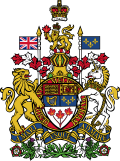Canadian Royal Family
| Queen of Canada | |
|---|---|
| Reine du Canada (French) | |
|
Federal
|
|

Royal Arms of Canada
(as revised in 1994) |
|
| Incumbent | |
 |
|
|
Elizabeth II since 6 February 1952 |
|
| Details | |
| Style | Her Majesty |
| Heir apparent | Charles, Prince of Wales |
| Residences |
Rideau Hall, Ottawa La Citadelle, Quebec City |
| Website | canadiancrown.gc.ca |
The monarchy of Canada is at the core of both Canada's federal structure and Westminster-style of parliamentary and constitutional democracy. The monarchy is the foundation of the executive (Queen-in-Council), legislative (Queen-in-Parliament), and judicial (Queen-on-the-Bench) within both the federal and each provincial jurisdiction. The Canadian sovereign is the personification of the Canadian state and is Canada as a matter of constitutional law. The current Canadian monarch is Queen Elizabeth II, who has reigned since 6 February 1952. Royal succession is determined according to common and statute law, which stipulates the throne is inherited by the sovereign's eldest living, non-Catholic child or, in the case of a childless sovereign, the nearest collateral line. As such, Elizabeth's son, Prince Charles, is heir apparent.
Although the person of the sovereign is equally shared with 15 other independent countries within the Commonwealth of Nations, each country's monarchy is separate and legally distinct. As a result, the current monarch is officially titled Queen of Canada and, in this capacity, she, her consort, and other members of the Canadian Royal Family undertake public and private functions domestically and abroad as representatives of Canada. However, the Queen is the only member of the Royal Family with any constitutional role. While some powers are exercisable only by the sovereign (such as appointing governors general), most of the monarch's operational and ceremonial duties (such as summoning the House of Commons and accrediting ambassadors) are exercised by his or her representative, the Governor General of Canada. In Canada's provinces, the monarch in right of each is represented by a lieutenant governor. As territories fall under the federal jurisdiction, they each have a commissioner, rather than a lieutenant governor, who represents the federal Crown-in-Council directly.
...
Wikipedia
